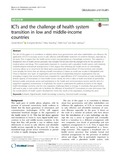ICTs and the Challenge of Health System Transition in Low and Middle-Income Countries
| dc.contributor.author | Bloom, Gerald | |
| dc.contributor.author | Berdou, Evangelia | |
| dc.contributor.author | Standing, Hilary | |
| dc.contributor.author | Guo, Zhilei | |
| dc.contributor.author | Labrique, Alain | |
| dc.date.accessioned | 2018-05-03T14:31:25Z | |
| dc.date.available | 2018-05-03T14:31:25Z | |
| dc.date.issued | 2017-08-07 | |
| dc.identifier.citation | Bloom, G., Berdou, E., Standing, H., Guo, Z., Labrique, A. (2017) ICTs and The Challenge of Health System Transition in Low and Middle-Income Countries. Globalisation and Health. 13 (56). | en |
| dc.identifier.uri | https://opendocs.ids.ac.uk/opendocs/handle/20.500.12413/13716 | |
| dc.description.abstract | The aim of this paper is to contribute to debates about how governments and other stakeholders can influence the application of ICTs to increase access to safe, effective and affordable treatment of common illnesses, especially by the poor. First, it argues that the health sector is best conceptualized as a ‘knowledge economy’. This supports a broadened view of health service provision that includes formal and informal arrangements for the provision of medical advice and drugs. This is particularly important in countries with a pluralistic health system, with relatively underdeveloped institutional arrangements. It then argues that reframing the health sector as a knowledge economy allows us to circumvent the blind spots associated with donor-driven ICT-interventions and consider more broadly the forces that are driving e-health innovations. It draws on small case studies in Bangladesh and China to illustrate new types of organization and new kinds of relationship between organizations that are emerging. It argues that several factors have impeded the rapid diffusion of ICT innovations at scale including: the limited capacity of innovations to meet health service needs, the time it takes to build new kinds of partnership between public and private actors and participants in the health and communications sectors and the lack of a supportive regulatory environment. It emphasises the need to understand the political economy of the digital health knowledge economy and the new regulatory challenges likely to emerge. It concludes that governments will need to play a more active role to facilitate the diffusion of beneficial ICT innovations at scale and ensure that the overall pattern of health system development meets the needs of the population, including the poor. | en |
| dc.language.iso | en | en |
| dc.publisher | BioMed Central | en |
| dc.rights | The Author(s). 2017. Open Access. This article is distributed under the terms of the Creative Commons Attribution 4.0 International License (http://creativecommons.org/licenses/by/4.0/), which permits unrestricted use, distribution, and reproduction in any medium, provided you give appropriate credit to the original author(s) and the source, provide a link to the Creative Commons license, and indicate if changes were made. The Creative Commons Public Domain Dedication waiver (http://creativecommons.org/publicdomain/zero/1.0/) applies to the data made available in this article, unless otherwise stated. | en |
| dc.rights.uri | http://creativecommons.org/licenses/by/4.0/ | en |
| dc.subject | Health | en |
| dc.subject | Technology | en |
| dc.title | ICTs and the Challenge of Health System Transition in Low and Middle-Income Countries | en |
| dc.type | Article | en |
| dc.rights.holder | The authors | en |
| dc.identifier.externaluri | https://globalizationandhealth.biomedcentral.com/articles/10.1186/s12992-017-0276-y | en |
| dc.identifier.team | Health and Nutrition | en |
| dc.identifier.doi | https://doi.org/10.1186/s12992-017-0276-y | |
| dcterms.dateAccepted | 2017-08-07 | |
| rioxxterms.funder | Default funder | en |
| rioxxterms.identifier.project | Default project | en |
| rioxxterms.version | VoR | en |
| rioxxterms.versionofrecord | https://doi.org/10.1186/s12992-017-0276-y | en |
| rioxxterms.funder.project | 9ce4e4dc-26e9-4d78-96e9-15e4dcac0642 | en |
Files in this item
This item appears in the following Collection(s)
Except where otherwise noted, this item's license is described as The Author(s). 2017. Open Access. This article is distributed under the terms of the Creative Commons Attribution 4.0 International License (http://creativecommons.org/licenses/by/4.0/), which permits unrestricted use, distribution, and reproduction in any medium, provided you give appropriate credit to the original author(s) and the source, provide a link to the Creative Commons license, and indicate if changes were made. The Creative Commons Public Domain Dedication waiver
(http://creativecommons.org/publicdomain/zero/1.0/) applies to the data made available in this article, unless otherwise stated.


